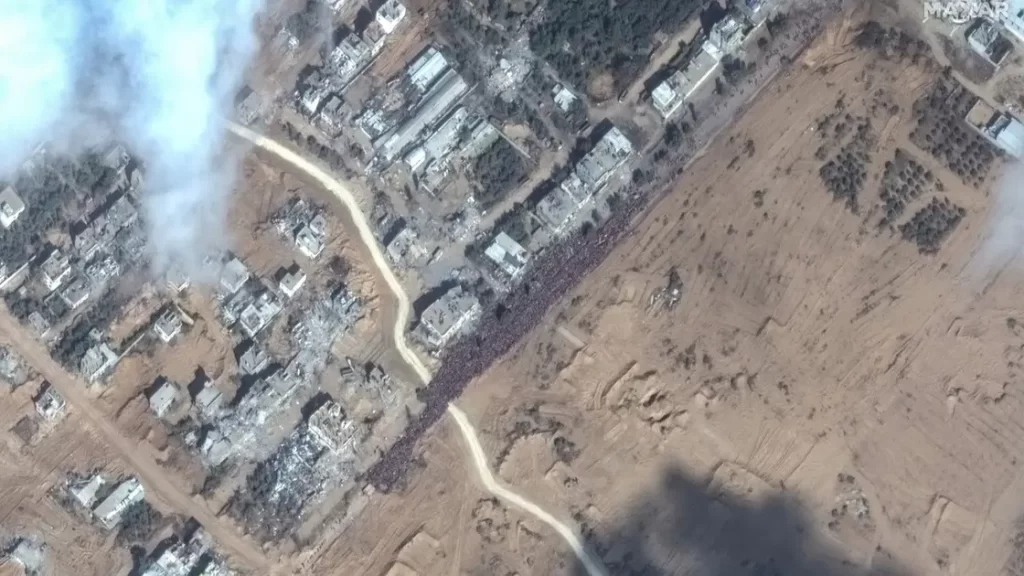Dozens dead in strike on Khan Yunis building: Gaza hospital director
Israel issued a fresh warning to Palestinians in the southern city of Khan Younis to relocate west out of the line of fire.
Gaza health authorities raised their death toll on Friday to more than 12,000 people, 5,000 of them children.
At least 26 people have been killed in a strike on a residential building in the southern Gaza Strip’s Khan Yunis region, the director of a local hospital said Saturday.
The director of the Nasser hospital told AFP the facility had received 26 dead bodies and 23 people with serious injuries after a strike on the residential building in the city of Hamad.
Call to leave
It came as Israel issued a fresh warning to Palestinians in the southern city of Khan Younis to relocate west out of the line of fire and closer to humanitarian aid in the latest indication that it plans to attack Hamas in southern Gaza after subduing the north.
“We’re asking people to relocate. I know it’s not easy for many of them, but we don’t want to see civilians caught up in the crossfire,” Mark Regev, an aide to Israeli Prime Minister Benjamin Netanyahu, told MSNBC on Friday.
Such a move could compel hundreds of thousands of Palestinians who fled south from the Israeli assault on Gaza City to relocate again, along with residents of the southern city of Khan Younis, worsening a dire humanitarian crisis.
Khan Younis has a population of more than 400,000.
Israel vowed to annihilate the Hamas militant group that controls the Gaza Strip following an Oct. 7 rampage into Israel in which its fighters killed 1,200 people and dragged 240 hostages into the enclave.
Since then, Israel has bombed much of Gaza City to rubble, ordered the depopulation of the entire northern half of the enclave and left homeless around two-thirds of the strip’s 2.3 million Palestinians.
Many of those who have fled fear their displacement could become permanent.
Gaza health authorities raised their death toll on Friday to more than 12,000 people, 5,000 of them children. The United Nations deems those figures credible, though they are now updated infrequently due to the difficulty of collecting information.
Israel overnight Thursday dropped leaflets over eastern areas of Khan Younis telling people to evacuate to shelters, suggesting that military operations there are imminent.
Regev said that Israeli Defence Forces will have to advance into the city to oust Hamas fighters from underground tunnels and bunkers, but that no such “enormous infrastructure” exists in less built-up areas to the west.
“I’m pretty sure that they won’t have to move again” if they move west, he continued. “We’re asking them to move to an area where hopefully there will be tents and a field hospital.”
Because the western areas are closer to the Rafah border crossing with Egypt, humanitarian aid could be brought in “as quickly as possible,” he said.
With the war entering its seventh week, there was no sign of any let-up despite international calls for a ceasefire or at least for humanitarian pauses.
“We have prepared ourselves for a long and sustained defence from all directions. The more time the occupation’s forces stay in Gaza, the heavier their continuous losses,” Abu Ubaida, Hamas armed wing spokesman, said in a video statement.
Amid warnings that its siege would cause starvation and disease, Israel on Friday appeared to bow to international pressure, agreeing to allow fuel trucks into Gaza and promising “no limitation” on aid requested by the United Nations.
Israel said it would allow two truckloads of fuel a day at the request of Washington to help the United Nations meet basic needs, and spoke of plans to increase aid more broadly.
“We will increase the capacity of the humanitarian convoys and trucks as long as there is a need,” Colonel Elad Goren, from COGAT, the ministry of defence agency that coordinates administrative issues with the Palestinians, told a briefing.
While Israel has promised to allow in aid in the past, the remarks appeared to signal a shift in tone after U.N. agencies warned that humanitarian conditions in Gaza were rapidly deteriorating, including a stark warning from the World Food Programme of the “immediate possibility of starvation”.
At Gaza’s biggest hospital, Al Shifa, Israel said its forces had found in two days of searching a vehicle with a large number of weapons and an underground structure it called a Hamas tunnel shaft.
The facility has been a primary target of Israel’s ground assault and a focus of international alarm over the deepening humanitarian crisis.
The army released a video it said showed a tunnel entrance in an outdoor area of the hospital, littered with concrete and wood rubble and sand. It appeared the area had been excavated. A bulldozer appeared in the background.
Israel has long maintained that the hospital sat above a vast underground bunker housing a Hamas command headquarters. Hospital staff say this is false and that Israel’s findings there have so far established no such thing.
Hamas denies using hospitals for military purposes. It says some hostages have received treatment at medical centres but they have not been held inside them.
Baby, hostage die
Al Shifa staff said a premature baby died at the hospital on Friday, the first baby to die there in the two days since Israeli forces entered. Three had died in the previous days while the hospital was surrounded.
Hamas also announced the death of a captive from Israel, an 85-year-old it said died of a panic attack during an air strike.
In Modiin, Israel, family held a funeral for Noa Marciano, 19, an Israeli army conscript whose body was recovered from Gaza City near Shifa hospital on Thursday. She had been abducted from a military base during the Oct. 7 Hamas onslaught.
The military said it had also recovered the body of Yehudit Weiss, 65, a mother of five who was seized from Kibbutz Be’eri.

